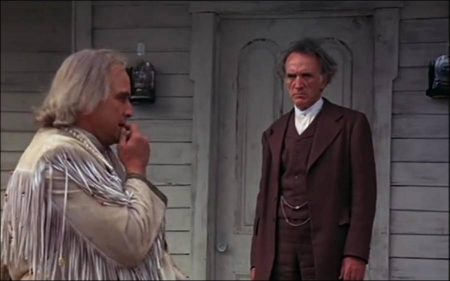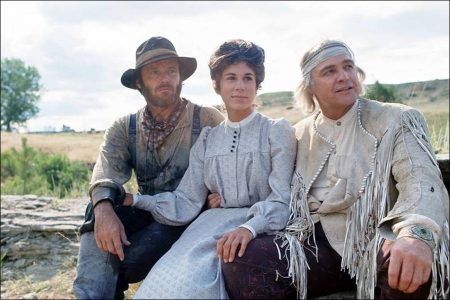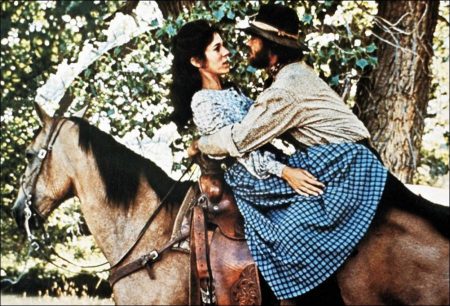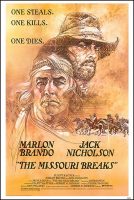Taglines: One steals, one kills, one loves, one dies.
The Missouri Breaks movie storyline. Tom Logan, (Jack Nicholson) is the likable leader of an amiable gang of horse thieves. They make their living stealing horses or rustling cattle from ranchers, laughing all the way, spending their money on whiskey and whores. Logan and his gang are particularly upset by the hanging of a friend by rancher David Braxton (John McLiam), an egomaniacal gay local land baron who took the law into his own hands. Braxton has horses, and a daughter, worth stealing.
Logan’s men pull off a daring train robbery, only to lose much of the money. The gang retaliates against Braxton by hanging his foreman Pete Marker (Richard Bradford) on the same noose. Posing as an aspiring cattle rancher, Logan buys an abandoned ranch next to Braxton’s to serve as a relay station for moving stolen horses across the plains.
While his men ride off across the Missouri River and north of the border to steal Canadian Mounted Police horses, Logan plants crops at their new farm and enters into a relationship with Braxton’s virginal daughter, Jane (Kathleen Lloyd). He knows how to court a woman by brewing Chinese tea in the Wild West. Jane is on bad terms with her father and has taken a shine to Logan in any event, seems to be fascinated by the bad guys and demands sex, saying: “Do you want to have sexual intercourse?” while flirting with Logan.
Braxton, obsessed with his rustling problem, his daughter, and avenging his friend’s murder, sends for Robert E. Lee Clayton (Marlon Brando), a notorious regulator from Medicine Hat, Wyoming, who, for a price, will take care of rustlers personally, one at a time. Regulators were mercenary frontier agents famous for their ruthlessness and their ability to kill without warning from long distances with their trademark Creekmore rifles.
The Missouri Breaks is a 1976 American epic Western film starring Marlon Brando and Jack Nicholson. The film was directed by Arthur Penn, with supporting performances by Randy Quaid, Harry Dean Stanton, Frederic Forrest, John McLiam, and Kathleen Lloyd. The score was composed by John Williams.
The title of the movie refers to a forlorn and very rugged area of north-central Montana, where over eons, the Missouri River has made countless deep cuts or “breaks” in the land. The action takes place in Montana in the 1880s among the tributary streams that eventually flow together into the Missouri River, an area known as the Missouri Breaks.
About the Production
In a May 24, 1976, Time interview, Brando was revealed to have “changed the entire flavor of his character—an Irish-American bounty hunter called “Robert E. Lee Clayton”—by inventing a deadly hand weapon resembling both a harpoon and a mace that he uses to kill. He said, “I always wondered why in the history of lethal weapons no one invented that particular one. It appealed to me because I used to be very expert at knife throwing.”
Brando broke the monotony of the production by playing childish pranks with rubber spiders and eggs, as well as frequently mooning the cast and crew. He would interrupt shots with bizarre behavior like biting a chunk out of a frog during a river scene, to taking potshots at grasshoppers instead of his firing a gun at co-star Nicholson as scripted. Director Penn apparently made no effort to control him.
Principal photography began on June 23, 1975. Jack Nicholson was the first actor to arrive on location with director Arthur Penn, the cast, and the crew. During the second week of filming in Nevada City, intermittent rain showers hit the area, which made the entire cast and crew more bedraggled than the script called for. More than 80 extras were used for area scenes; most of them were local people and children.
A narrow-gauge car was lost for a week while en route from Chama, New Mexico, to Harrison, which arrived after being held in Salt Lake City for interstate transportation permits. A scene that required the car was filmed on a trestle, four miles from Harrison on the abandoned Red Bluff Railroad. After filming was completed there, the cast and crew went on to Virginia City. In mid-July, Marlon Brando arrived in Montana to begin filming in Billings on a ranch near the city.
In August, while filming a scene on the Yellowstone River that requires the two main characters on horses and crossing the river, one of the horses, named Jug, drowned accidentally while in the water. In question, the film’s production executive said Jug died of shock when he was in the water. He explained that the horse hit a (submerged?) car body with one hoof and had a heart attack. An investigation was required, and the authorities came to the conclusion that it was an accident.
According to a spokesman for the Billings Humane Society, though, the sheriff’s investigation was unsatisfactory. The set was closed for a few weeks to everyone and no discrimination was involved. After the horse’s drowning and the injury of several others, including one by American Humane Association-prohibited tripwire, this film was placed on the AHA’s “unacceptable” list.[4] By the end of August, Brando had completed filming and left Montana. Nicholson stayed behind with the crew and cast. Production then headed to Red Lodge for two weeks to complete filming, and it was officially wrapped in mid-September 1975.
The movie was filmed on location in Montana: Billings, Bovey Restorations, Nevada City, Red Lodge, and Virginia City
The Missouri Breaks (1976)
Directed by: Arthur Penn
Starring: Marlon Brando, Jack Nicholson, Randy Quaid, Kathleen Lloyd, Frederic Forrest, Harry Dean Stanton, Luana Anders, Richard Bradford, Danny Goldman, Hunter von Leer, Sam Gilman
Screenplay by: Thomas McGuane
Production Design by: Albert Brenner
Cinematography by: Michael Butler
Film Editing by: Dede Allen, Gerald B. Greenberg, Steven A. Rotter
Costume Design by: Patricia Norris
Set Decoration by: Marvin March
Art Direction by: Stephen Myles Berger
Music by: John Williams
MPAA Rating: None.
Distributed by: United Artists
Release Date: May 18, 1976
Views: 222



